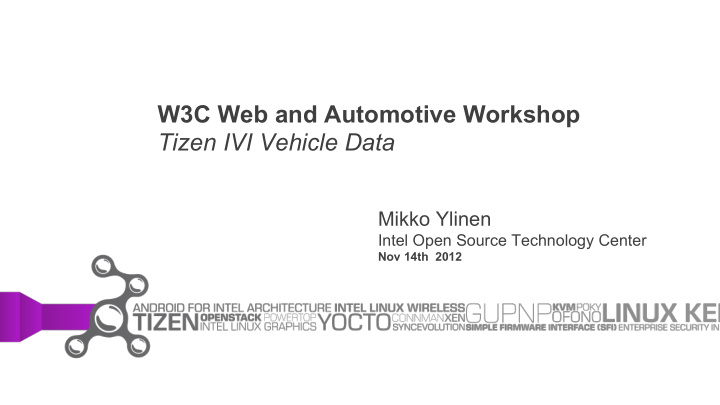



W3C Web and Automotive Workshop Tizen IVI Vehicle Data Mikko Ylinen Intel Open Source Technology Center Nov 14th 2012
Agenda • Position Paper Highlights • The API • Demo Setup and Architecture 2
Position Paper Highlights (1/2) • In order to be able to provide automotive rich UI and applications, an access to IVI system provided data is needed. Ideally, this is done through standardized automotive Web APIs. • To date, there's no standardized Web API for IVI to access automotive data. Furthermore, different car manufacturers (or even different car models) can provide very different data items. • Different parties, e.g., GENIVI or Webinos, have started to specify their own specifications for automotive Web APIs. 3
Position Paper Highlights (2/2) • Some design principles for a Vehicle Web API • The API is lightweight and provides getting and setting data items • The API implements an extremely minimal set of data items that are the base set required for compliance • The API has mechanisms for event based updates to requested data items • The API implements a method for a Web application to query for supported data items, so graceful functionality degradation is possible 4
The API get(eventlist, successCB, errorCB) • Retrieve the specified data values, or all data values if blank set(eventlist, valuelist, successCB, errorCB) • Set the specified data values getSupportedEventTypes(type, writeable, successCB, errorCB) • Retrieve the list of events available on the platform subscribe(eventlist, successCB, errorCB) • Subscribe to update events for the specified data items unsubscribe(eventlist, successCB, errorCB) • Unsubscribe from update events for the specified data items 5
Example code - events function engineSpeedEvent(data) { var newRPMs = data.value; } function onLoad() { vehicle.subscribe(["speedometer", "engine_speed"]); document.addEventListener("speedometer", function(data) { var newSpeed = data.value; }); document.addEventListener("engine_speed", engineSpeedEvent); } 6
Example code - set function setDriverHeight() { vehicle.set("driver_seat_position_headrest", 10, function() { console.log("Driver headrest set successfully!"); }, function(error) { console.log("Error setting Driver headrest value: " + error.message); } ); } 7
API FIXME • Create a WebIDL definition from the API • Improve API’s successCB and errorCB handling • Listen feedback, re-iterate 8
Demo Description Abstract: This demo shows how the Automotive Message Broker can be used to translate the action of a steering wheel, pedals, gear shift or any other vehicle information into data that can be displayed in a web application. Tizen includes the Automotive Message Broker which abstracts CAN messages and other low level vehicle information and exposes them to developers as a high level API. Hardware: Logitech steering wheel (inc. pedals, gear stick), NDiS-166, 2 monitors 9
Demo Pics 10
Tizen IVI Web API Prototype GhostCluster Web Applications app websocket connection Automotive Message Broker Middleware wheel websocket AMB Core source sink + API Input layer Kernel Joystick wheel 11
Tizen IVI Web API Final Architecture A Web Web Applications app Automotive Message Broker Tizen Web Runtime Middleware Car BUS WRT Vehicle API WebKit+ AMB Core source sink Plugin JS Core Car bus driver Kernel Car bus 12
Performance View • Environment: from HW to AMB core • Wheel plug-in: 2000+ properties per second, < 5% CPU • OBD-II plug-in: 80-100 properties per second 13
the Code • API definition https://github.com/otcshare/automotive-message-broker/blob/ master/plugins/websocketsink/test/api.js • Demo Web App https://github.com/otcshare/GhostCluster 14
Recommend
More recommend